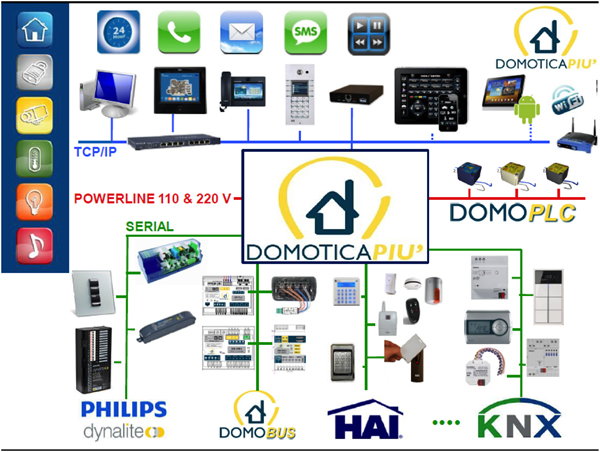 By Carlo Natale, Domotica Più.
By Carlo Natale, Domotica Più.
Over the past few decades, the majority of home and building electronic systems (HBES) manufacturers have thoroughly investigated and exploited cables as a medium of communication between their products. From the trade’s point of view, the market is now well established and has led to KNX being adopted by the majority of these manufacturers worldwide.
More recently, many of these companies have turned their attention to the wireless technology sector in expectation of a return on their investments as the specific market shares change. The promoters of wireless are well aware however, of the limitations of the technology in the field. Low-power-consumption wireless technologies cannot achieve reliable performance over longer distances unless they increase their mesh coverage by adding more electronic devices. Wide-range wireless technologies have high power consumption levels and implementation costs. Furthermore, the number of end-users who are against having wireless antennas in their installations is increasing, and the physical space for the required devices is also a limiting factor in both new and retrofit installations.
In the meantime, relatively few HBES manufacturers have invested in powerline, but this could be a missed opportunity, especially when it comes to KNX networks. It is true that of those systems integrators who have tried the technology in the past, many have had less than satisfactory experiences due to poor-quality products using cheap components, noisy networks, insufficient data rates and the lack of protocols or compliance with technical norms. Things may however, be about to change.
Narrowband and Broadband Powerline
The term ‘powerline’ is a little too generic for our purposes, so we need at least to divide the technology into two main categories: powerline narrowband (NB) and powerline broadband (BB).
It may come as a surprise, but reliable narrowband powerline mesh networks already exist in most countries. Networks of millions of devices are already successfully communicating in the field, exploiting the existing L phase and N neutral wires as a bus system for vertical applications.
Whereas the principles of powerline technology date back to the early 1920s, it was only in the 1970s that the technology was really seen to emerge, in the form of X10. Many attempts with this were tried and many died, but it was only a matter of time before we started seeing some success as research and innovation continued and boundaries were pushed.
My company has been involved in the phase II re-engineering of a system that integrates powerline products with the already-established KNX system configuration. This shows the potential flexibility of hybrid installations that can exploit the strengths of wired, wireless and powerline, the balance of which depends on the application and on the specific installation circumstances. An example of this is shown below.
If all of this were possible, I can see a growing number of systems integrators adopting powerline as part of their systems mix, because the advantages are fairly obvious in terms of ease of installation, flexibility and cost-effectiveness.
Conclusion
Given the financial slowdown of the new home and building market in many countries, and given the effectiveness of new powerline solutions, particularly for, but not exclusive to, retrofit applications, as systems integrators look to diversify, the benefits of powerline will be increasingly difficult to resist.
Powerline technology has huge potential, and I can see it growing as an alternative to wired solutions to the point where it exceeds half of all newly-specified retrofit projects.
Carlo Natale is the President & CEO of Domotica Più, a company that specialises in innovation and international consultancy and manufacturing services for HBES operators. Contact Carlo via c.natale@domoplus.it or telephone +39 366 5318639.












